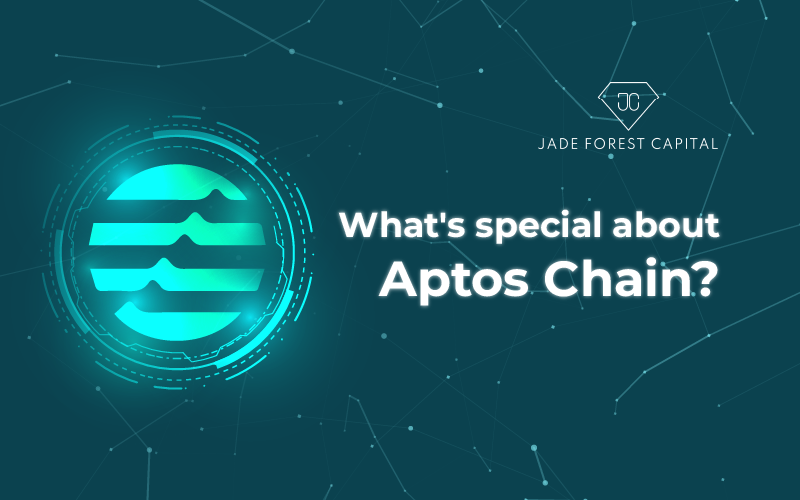Recently, a network has surprised investors after it airdropped USD 1,500 – 3,000 to users to thank them for their support over the past period. You probably know which platform we’re talking about. It’s Aptos, a new kid on the block that has made impressive strides lately. Jade Forest Capital believes that Aptos can be a bright spot in the downtrend market, when it can become noticed and attract money flow.
However, users also need to stay conscious as these achievements are what enchants scammers and hackers. Therefore, Jade Forest Capital will go through this new blockchain to give readers more insights into it.
What is Aptos?
Source: https://aptoslabs.com/
Aptos is a layer-1 blockchain designed with scalability, safety, reliability, and upgradeability as key principles. The network uses the Move programming language, a language originally developed for Diem (formerly known as Libra).
Aptos can process over 120k transactions per second using its parallel execution engine (Block-STM), which results in low transaction costs for users.
What is the Move programming language?
It can be said that Move – the programming language of Aptos, can be considered a central focus of the project. While previous layer-1 blockchains would normally develop the Solidity-based programming language on Ethereum for easy integration, Aptos utilizes a new language, which shows its strong potential and development capacity.
The Move is designed to provide security for the network, allowing transactions to be measured and verified implicitly. This means that a transaction can be predicted just based on the transaction information. Furthermore, the Move can resist the denial-of-service (DoS) attack.
In the Move language, the sender of the transaction is represented by the signer – the verified owner of a particular account. The signer is the highest authority and the only legal entity who can add resources to the account. Besides, module developers can require signers to access resources or modify content in the account.
Aptos uses a low-latency Byzantine Fault Tolerant (BFT) mechanism. The Aptos team has focused on building this algorithm for a long time to complement their BFT mechanism, ensuring network safety even if the nodes get manipulated and attack the network. Moreover, it also has the ability to change the private key to increase the security level for users.
In laboratory conditions, if ignoring many factors about storage, consensus mechanism, network, etc., Aptos’s TPS can reach 125,000 – 160,000 transactions per second.
The formation of Aptos
The mainnet of Aptos Chain can be seen as a crucial milestone for this blockchain. The network has undergone a long and multi-stage formation process to launch its mainnet. Let’s look at the Aptos’ formation and development with Jade Forest Capital to understand more.
2022 Q1 (March 15) – Launching Devnet for developers
- Deploy Devnet and work with strategic partners. Motivate the community to experience the testnet network and collect their feedback. Then implement activities to improve the Move experience for developers and the Move language.
2022 Q2 – Introducing incentivized testnet
- Launching a larger testnet platform akin to the mainnet for strategic partners and web3 developers.
- Work with node operators to let them engage and build expertise in decentralized networks together.
- Implement a bug bounty to discover vulnerabilities in the network to fix and improve the developer experience, node operations, and infrastructure issues.
- Offer incentives to all participants who help secure the network.
2022 Q3
- Mainnet public
2022 Q4 – 2023 Q1
- Roll out the next major release to the Aptos mainnet with a set of important features.
It can be seen that after the mainnet of Aptos, projects began to be implemented actively and the number of users also increased rapidly, showing the initial success of the Aptos team. However, the team still has more to do in the future. The aforementioned roadmap is a summary of the formation and development of Aptos over the past period.
Aptos’s tokenomics
On the morning of October 19, many exchanges announced the listing of APT but Aptos has not published any information about its tokenomics, leading to mixed opinions and suspicion in the community. Tokenomics describes the factors that impact a token’s use and value, including the token’s creation and distribution, supply and demand, incentive mechanisms, and token burn schedules. These are the basic information that each project must provide for users to make investment decisions. Aptos has not announced their tokens, but they are still listed on major crypto exchanges, which is one of the reasons why Aptos is facing strong opposition from the community.
Until the afternoon of October 19, Aptos announced its tokenomic as follows:
1/ Creating a network for the people requires a tokenomics designed with the community and fairness at its center.
— Aptos (@Aptos_Network) October 18, 2022
The overview of that tokenomics is available here: https://t.co/KeU7RXANkd
At the time of mainnet launch on October 12, 2022, the supply of APT is 1 billion coins, distributed to:
– Community: 510,217,359.767 APT (51,02%)
– Core members: 190,000,000 APT (19%)
– Project budget: 165,000,000 APT (16,5%)
– Investors: 134,782,640.233 APT (13,48%)
Out of the total APT supply offered to the community, 410,217,359.76 APT will be managed by the Aptos Foundation, while the remaining 100 million will be managed by Aptos Labs to develop its ecosystem over the next 10 years.
Meanwhile, the amount of APT distributed to core members and investors will be locked for 1 year and paid monthly for the next 4 years.
Uses of APT
APT is the native token of Aptos that is used to:
- Make transaction fees: when transferring money or using products from projects on Aptos Chain, APT will be used as a fee for transactions to be made.
- Buy and sell assets on Aptos: users can store APT to exchange for other tokens on the network to increase profits.
- Stake to ensure network security and earn more APT: users can use APT to stake. This helps secure the network and gives users newly issued APT tokens.
- Act as a network administrator: users who own APT can vote to change project parameters and decide on other issues such as inflation rate from staking, burning APT, transaction fees, etc.
Additionally, as the network grows stronger, APT will be upgraded to have more uses in the future.
Is Aptos the potential Solana killer?
Despite being launched about a week ago, Aptos has been garnering tremendous attention from investors. The fact that Aptos is predicted to become the Solana killer is one of the hottest topics. This is because the transaction speed of Aptos reaches 120,000 TPS whereas that of Solana is only 60,000 TPS. Moreover, the entire Solana ecosystem also shut down many times, which we have already witnessed during the past time.
In addition to its high scalability, Aptos also shares similarities with Solana, including strong funding and a “top-down” approach to building the ecosystem. With several billion dollars of funding and the allure of “something new,” Aptos could well replace Solana’s in the future if it can develop a flourishing ecosystem.
Nevertheless, it is not enough to say that Aptos is the Solana killer as the Solana ecosystem has developed for a long time with a network of loyal users. More importantly, the tokenomics of Aptos has not been announced and most of the supply goes to early investors, leading to an unfavorable start of the network that may have long-term effects. However, if Aptos achieves even half of what they have claimed in terms of technology, it will capture significant market share from all other smart contract-enabled layer-1 networks.
Conclusion
At any rate, Aptos is still a very young network, so it takes time to evaluate its capacity and potential. During this period, Aptos not only attracts attention from investors but also scammers. Therefore, users need to be well-prepared and have plans to avoid those scams.


